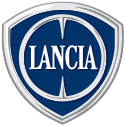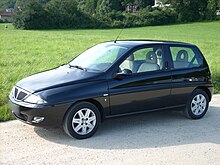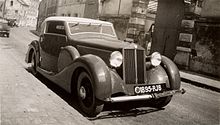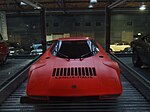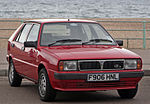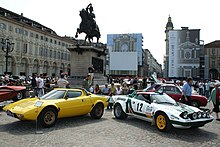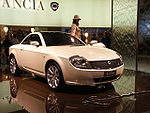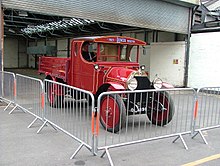Lancia
| Lancia Automobiles
|
|
|---|---|
| legal form | Società per azioni |
| founding | November 29, 1906 |
| Seat |
Turin , Italy |
| management |
|
| Branch | Automotive industry |
| Website | www.lancia.com |
Lancia [ ˈlantʃa ] is an Italian automobile manufacturer based in Turin . The company was founded in Turin in 1906 and has been part of the Fiat group since 1969 .
The traditional manufacturer can look back on pioneering achievements in automobile construction (e.g. through the first self-supporting body ) and has also been successful in rallying for a long time . The brand's vehicles have always stood for a high affinity for design, which in the past was characterized by numerous and sometimes unusual body variants, later also by a special selection of materials and design solutions.
From 2009 Lancia cooperated with Chrysler . Lancia was involved in the design of both brands, slightly modified Chrysler vehicles were offered as Lancia models in Europe. In 2014 it was announced that the production of vehicles with the brand name Lancia would be phased out. Since the end of April 2017, the last model Ypsilon still to be built has only been offered in Italy.
history


1906 to 1969
On November 29, 1906, the Lancia company was founded by Vincenzo Lancia and his friend, the former Fiat test driver Claudio Fogolin . Lancia is therefore one of the oldest automobile manufacturers. Carlo Biscaretti di Ruffia designed the first Lancia logo in 1911. It shows a valance and a lance, as the name Lancia means lance in Italian. The nomenclature of the models followed the Greek alphabet, variants were prefixed with a di- or a tri- .
New models were constantly being presented, so that only a few came up with large numbers. The change was due to the numerous patents that were always implemented to differentiate themselves from the competition. The Lancia Theta, presented in 1913, was the first car in Europe to have an electrical system and was also the first car with a starter and illuminated instruments. The Lancia Lambda presented in 1923 with independent front suspension and hydraulic shock absorbers was the first vehicle with a self-supporting body . Compact V-engines with very small angles (around 15 °) between the cylinders were typical for Lancia. Lancia had the reputation of being the “Engineer's Brand” because of its well thought-out designs.
The large factory gate was built between 1919 and 1922 (on the corner of Corso Peschiera and Corso Racconigi). The Art Nouveau portal building was designed by Michele Frapolli and has been preserved to this day.

Like most Italian automobile manufacturers , Lancia didn't just build cars . The brand was also a recognized player in the commercial vehicle sector , building trucks and buses of all types and sizes, as well as trolleybuses and military vehicles . Two automobile series were offered, one in the middle class and one in the upper class, both mostly only as sedans. The design and execution of the numerous coupés, convertibles, roadsters, etc. was left to external bodybuilders with whom Lancia cooperated. In 1922 Boneschi manufactured vehicles based on the Lancia Lambda, Pininfarina supplied the Aprilia Coupé in 1937 . Sales in German-speaking countries were carried out from 1925 to 1960 by the Viennese company Smoliner & Kratky, which also opened a Lancia car dealership on Vienna's Ringstrasse (Stubenring). In the Second World War, Lancia was obliged by the Wehrmacht to only produce trucks.
After 1945, Lancia was unable to serve the growth market of simple, cheap, mass-produced cars. They continued to rely on cars that were expensive to build, such as sedans without a B-pillar in the entrance. The first six-cylinder V-engine mass- produced by Lancia was used in the Lancia Aurelia from 1950 . At 60 degrees, the angle of the cylinder banks was no longer as narrow as on the older engines. The “bogus” V-engine (each connecting rod had its own crankshaft crank pin) was considered to run very smoothly (the fact that it produced only 56 hp with 1754 cm³ contributed to the smooth running of this engine). The drive and axles were also unusual: the clutch, transmission, differential and internal drum brakes were arranged as a unit between the rear wheels. A trailing arm axle at the rear had not existed before either.
In 1953 the 70 m high Lancia skyscraper was inaugurated. The building in Turin was designed by Nino Rosani and Gio Ponti as a bridge over the public street Via Vincenzo Lancia , which separated two factory sites.
After Lancia's works driver Alberto Ascari had a fatal accident during test drives in 1955, Lancia gave away its Formula 1 division to Ferrari and stopped all motor sport activities for nine years. In 1956 Juan Manuel Fangio became world champion with a Lancia-Ferrari D 50. In the same year Gianni Lancia sold the majority of the company to the Italcementi group under Carlo Pesenti. The highly acclaimed Lancia Florida I & II studies could be carried out with new money . They were designed by Pininfarina . On April 2, 1955, Prof. Antonio Fessia (1901–1968) was poached from Fiat to Lancia and appointed technical director. This initiated numerous changes, including the newly designed 2.5-liter V6 engine. 1957 the upper class model Lancia Flaminia was presented.
In the period that followed, numerous variants of the two Lancia series were also produced as coupé, sports car, roadster or convertible from external body shops. At that time, the brand's six-cylinder vehicles in particular were very expensive and preferred by a small target group. Only this price policy made the wide range of body variants possible. In the 1962 film In Love with Sharp Bends , the protagonist Bruno, a law student from a good family, drives an Aurelia as a convertible and constantly attracts attention with his aggressive driving style. The cars were imported into the USA by Max Hoffman , who u. a. also initiated the Mercedes 300 SL and promoted the Porsche 356 . Lancia was one of the manufacturers of the best quality automobiles, but made losses over the years. Most recently, attempts were made to limit the model range to 16 variants and three series, but even the smallest model still cost 9,300 marks. “ Die Zeit ” counted Lancia among the vehicles of the “upper-class urge for recognition” .
In 1969 the Italcementi group wanted to separate from Lancia. BMW Sales Director Paul G. Hahnemann negotiated with the major Lancia shareholder Pesenti and the Vatican , which held a 35% stake in Lancia SpA. The interest of BMW was based on the fact that it was of the opinion that the image and reputation of the Lancia brand matched BMW. Ultimately, the takeover failed due to different price expectations. Mercedes-Benz had also shown interest in the brand.
1969 to 1986
When Fiat finally bought the company, the purchase price was only a symbolic amount, as the mountain of debt had grown enormously and Carlo Pesenti did not want to make up the deficit from the cement business. After the takeover, Fiat reacted by lowering the price of its Lancia models, but a large price difference to the cheaper competitor Alfa Romeo remained. A year after the takeover, Lancia received an order, which had been negotiated for years, to participate in the production of the Leopard tanks. The truck section went to the expiry of the last model 1972 (Esagamma E) from the year 1975 in also to Fiat belonging Iveco on. Since then, Lancia has concentrated on cars and gradually intensified its motorsport involvement.
The nomenclature with the Greek alphabet was reintroduced into the models (in the meantime: Roman roads), which began with the introduction of the Beta mid-range car in autumn 1972. This was available as a sedan (Berlina), coupé (from 1973), station wagon HPE (from 1974), Spider (from 1974) and as a sporty mid-engine coupé Montecarlo (from 1975) from Pininfarina. Some Lancia Beta had a cockpit designed by the famous Italian industrial designer Mario Bellini . The Beta not only introduced modern manufacturing methods, but using components from other manufacturers such as Fiat and Citroën also significantly reduced costs. A derivative of the Beta was the Trevi notchback sedan , which was offered from 1980. In contrast to the inconspicuous, conservative body design, there was the Bellini cockpit and, from 1982, the Volumex engine by the designer Aurelio Lampredi .
Not least in order not to lose the customers of high-priced models, Lancia presented the super sports car Lancia Stratos in 1971 , motorized with the V6 unit of the Dino 246 GT from Ferrari and built by Bertone. At that time, Franz Beckenbauer was advertising Lancia in Germany.
Fiat - the parent company of both Lancia and Autobianchi - decided in 1975 to put the Autobianchi plant under the direction of Lancia, since most dealers already carried both brands and so the Lancia program could be rounded off ideally due to the same target groups. At the same time, the previously legally independent Lancia & C. Fabbrica Automobili SpA was incorporated as a division into the newly founded Fiat Auto SpA, with which the group intended to bundle its business with passenger cars and light commercial vehicles.
In spring 1976 the Lancia Gamma followed in the upper middle class , which was available as a hatchback sedan and from spring 1977 also as a coupé. Corresponding studies for a station wagon, a Spider and a minivan remained unrealized. In 1978 Lancia negotiated the establishment of an assembly factory in Austria that would produce 15,000 cars a year.
The new segment of the compact class was served from autumn 1979 with the new Delta , which was manufactured in the Chivasso plant. The notchback version was the Prisma , offered from the end of 1982 , which was also available with selectable all-wheel drive. Again various variants were created, this time as road versions of racing versions of the Delta, including the widened Delta Integrale and Delta Integrale Evoluzione (the Delta S4 alias Abarth SE038 as a mid-engine vehicle followed a different conception from a technical perspective). At that time, the Lancia model range was much more sporty than that of the Fiat brand.
In 1982 Lancia reintroduced the Roots blower , a compressor , to the automotive industry. This technology, which was known earlier, but has hardly been used since the early 1930s, was used at Abarth in Turin for Lancia rally cars. In order to amortize the high development costs for the compressor known as "Volumex" and to reduce manufacturing costs, Lancia equipped certain versions of the Lancia Beta with it. At the same time, the Lancia engine plant in Verrone developed the brand's expertise in the construction of turbo engines.
1986 to 2008
In the autumn of 1986 Fiat acquired the previously state-owned Alfa Romeo group and merged its auto division with the previous Lancia division in the new, independent company ALFA LANCIA Industriale SpA .
Before that, Lancia presented the futuristic Y10 at the Geneva Motor Show in March 1985 as the successor to the long-standing bestseller A112, paving the way for a new class of luxurious, high-quality small cars. Like the A112, which rolled off the assembly line in a unified version until the end of 1986, the Y10 was also built by Autobianchi (under Lancia since 1975) in Desio near Milan.
Lancia developed the theme together with Saab , Fiat and Alfa Romeo . Initially launched as a notchback sedan in autumn 1984, from the end of 1986 Lancia also offered this upper mid-range model as a high-quality lifestyle station wagon designed (and built there) by Pininfarina. In 1986, the top-of-the-line version was the Thema 8.32, developed in cooperation with Ferrari - the first and so far only sedan with a Ferrari engine. Lancia also built versions with an extended wheelbase for representational purposes, especially as a vehicle for heads of state. The hatchback was reserved for Saab, which offered the sister model as the Saab 9000 . The Fiat model Croma was equipped with a hinted notchback, but had a large tailgate. The Alfa Romeo 164, however, only used the same floor pan and had its own notchback body. Both Thema and the Saab 9000, Fiat Croma and Alfa Romeo 164 had the characteristics of the respective brands. This cooperation also resulted in the Saab 600 as a Scandinavian version of the Lancia Delta, and Saab also sold the A112 there.
In the spring of 1989, the new mid-range Dedra model was launched , replacing the Prisma, which was particularly successful on the Italian market. The Dedra was able to continue the sales success of the Prisma straight away, so that steadily growing sales figures could be registered in Turin, because in 1991 Lancia achieved a new sales record with a total of 308,400 units sold. Following the corresponding market presence, the marketing communication concept at that time provided for a variety of sponsoring activities, particularly in tennis and golf, but also in popular sports (e.g. from 1991 to 1993 at TSV 1860 Munich ).
In the spring of 1993, Lancia presented the second generation of the Delta (836 series) and the estate version of the Dedra followed in mid-1994. The previous main plant in Chivasso was sold to the bodybuilder Maggiora , who was allowed to continue manufacturing the first Delta (831 series) for a year. Maggiora realized numerous special series and one-offs based on the Delta Integrale Evoluzione . On the initiative of a Dutch dealer, Zagato drew and manufactured a small series of the Lancia Hyena - in fact the only coupé version of the Delta 831. However, to do this, you had to buy ready-made series vehicles of the Delta Integrale Evoluzione in stores and then dismantle them, as Lancia had no authorization for the project Template. At this time, the parent company Fiat SpA dissolved the company ALFA LANCIA Industriale SpA , so that the respective brands were again managed as divisions of the Fiat Auto SpA, which was supplemented with it. The occasion on the market side was a new integrated overall marketing concept from Fiat Auto SpA, which assigned specific missions to the individual brands. On the operational level, Lancia's new main plant was the production facilities in Rivalta near Turin, where (until 2002) all series except the Y10 rolled off the assembly line.
In the late summer of 1994, Lancia presented the Lancia Kappa as the successor to the Thema in Paris . In addition to the sedan and the station wagon built by Pininfarina from mid-1996, Lancia also introduced the Lancia Kappa Coupé in spring 1997 . It was the first coupé since the Gamma discontinued in the summer of 1984. In line with the tradition of all coupés of the brand, it was developed with an external bodybuilder (in this case Maggiora) and manufactured there in small series. From autumn 1994, Lancia also served the van segment with the Zeta in the Eurovan group , with the Lancia Megagamma, designed by Giugiaro, anticipating the minivan wave as a show car as early as the early 1980s. In 2002 the Phedra replaced the Zeta. At the same time, the three equipment variants LE , LS and LX gave way to the new names Argento , Oro and Platino . In autumn 1995 the Y10 successor Lancia Y appeared .
From the 1998 study presented Lancia Dialogos was thesis derived, which was presented to the public in autumn 2,001th With it Lancia wanted to establish an avant-garde car in the conservative segment of the luxury class. The thesis was unsuccessful in sales. Various details such as the LED rear lights that were introduced for the first time or the narrow C-pillar were later found in other brands.
The growing segment of luxury small cars was increasingly discovered by other brands, so that the Lancia Y now faced serious competition. The BMW Mini came at the end of 2001 and the Audi A1 followed in summer 2010 . The new generation of the Ypsilon small car - now advertised - came onto the market in autumn 2003, followed by the compact MPV Lancia Musa in summer 2004.
The brand communication of Lancia takes place less via car dealerships 'on the greenfield', but rather via inner-city showrooms, which are operated as Lancia Café . The third generation of the Lancia Delta (844 series) was launched in late summer 2008.
2009 to 2017
With the takeover of the American Chrysler Group by the Fiat Group, a far-reaching cooperation between the Lancia and Chrysler brands began in January 2009, ranging from development to sales. The smaller models were developed and manufactured in Europe, the larger and the vans in North America. Regional differences also exist with regard to the engines. It was sold in Europe under the Lancia brand (with the exception of the UK, Ireland, Russia, Ukraine) and in the remaining markets as Chrysler. The head of the Chrysler / Lancia brand, Olivier Francois, characterized the merger: "... like a brand whose name is pronounced differently in Europe and the USA ..." . Only the separate Jeep brand is available in all markets.
In autumn 2011 the series versions of the new models were presented at the IAA . In addition to the new Lancia Ypsilon , Lancia Musa and Lancia Delta, the range also included the new Lancia Flavia (Cabriolet), the new Lancia Thema and the Lancia Voyager , of which the latter are three new Chrysler developments.
This type of transatlantic cooperation was nothing new. Numerous Italian sports car companies rely on Chrysler's know-how in the production of V8 engines, which they then adapt to European requirements in their own bodies. For Chrysler, the collaboration meant a significant upgrade in automotive design, especially the interior, while Lancia was able to offer a wider range of models. Even though it was a real cooperation and no product was offered under two names in one market, the press often reported that it was badge engineering . In Europe in particular, sales of the new models remained low. The concept was abandoned in 2014, the model range was limited to the Ypsilon and the Voyager.
In March 2015, the group management announced that Lancia was withdrawing to its home market of Italy. Finally, at the end of April 2017, Lancia stopped exporting to other countries.
Lancia in motorsport
Lancia took part in races as early as 1927 . At the Mille Miglia , which was held for the first time , three Lancia Lambda finished fourth, fifth and sixth. A year later, Ermenegildo Strazza was third and Luigi Scarfiotti was seventh. At the Targa Florio in Sicily , which was only advertised for series touring cars in 1936 , the Lancia Augusta took the first four places. Gaston Descollas and Joe Fry continued their Lancia Aprilia successful in hillclimb one.
In 1951 the new Aurelia B10 with an engine enlarged to 1991 cc was used in the 1800-kilometer Sestriere Rally , and Alberto Ascari took overall victory. In the 1951 Tour of Sicily, Lancia achieved a double victory in the Gran Tourismo class over 1500 cc with the new Aurelia B20. At the III. Carrera Panamericana 1952 Lancia started with the Aurelia B20 with Roots supercharger and came third behind Mercedes and Ferrari.
Lancia cars were often used in rallying. Scuderia Lancia celebrated some successes with Lancia D24 and its driver Juan Manuel Fangio in 1953. The Scuderia Lancia then also worked for a short time in Formula 1 with the Lancia D50 . After their driver Alberto Ascari died in 1955 as a result of a serious crash in Monza , Lancia gave its six cars away to Scuderia Ferrari , which became world champions in 1956 with the Ferrari-Lancia D50. The official World Rally Championship had existed since 1970 . There the Lancia Fulvia was used, which won the first world title in 1972.
Famous also the Lancia Stratos, which was 1974 - 1976 the manufacture WRC won. One of the most famous drivers was Sandro Munari . He achieved 13 victories and won the world title in 1977 . The Lancia Beta Monte-Carlo was used in Group 5 under 2000 cm³ and was world champion in 1980 and 1981 . The model was then revised and the Lancia Rally 037 was created . Drivers like Walter Röhrl outdated 1982 - 1985 a number of victories in the World Rally Championship and in 1983 you could see the brand world title celebration. In addition, the Lancia LC1 with 450 PS (331 kW) was used for Group 6 and the Lancia LC2 with 800 PS (588 kW) was used for Group C. Drivers like Riccardo Patrese achieved several victories here with the Martini Racing Team, Porsche was rarely beaten, but the successes were a respectable achievement.
Then came the time of the Lancia Delta. Several titles were won in different versions (S4, up to 1986 ; 4WD up to 1987 ; integral up to 1988 ; integral 16V up to 1989 ). The Lancia Delta S4 took the world title in 1986 in the Group B . The so-called "Group B monsters" had 400 to 550 hp, but could only be driven by a few top pilots at the limit. The Finnish Lancia works driver Henri Toivonen and his co-pilot had a fatal accident in a Delta S4 at the 1986 Corsica Rally . The Group B was due to other serious accidents also by the FIA banned again from rallying. In Group A , it went better and the Lancia Delta lasted until 1992 in the business. The brand world championship was won from 1987 to 1992. World champions were Juha Kankkunen (1987 and 1991) and Miki Biasion (1988 and 1989).
It is fair to say that Lancia played an extremely important role in rallying. The Monte Carlo Rally alone has been won eleven times with a Lancia since 1973. In the World Rally Championship there have been nine world champions with a Lancia car since 1970. The Lancia Delta integrale is still considered the most successful rally car of all time. He won the brand world championship six times in a row. Such a success has not been repeated with any other vehicle.
As part of the integration of Alfa Romeo into the Fiat group, the management changed the direction of the Lancia brand as a whole and also ended its involvement in motorsport on December 18, 1991 with an official press release in favor of Alfa Romeo. The former Lancia Abarth rally team, headed by chief technician Ing.Sergio Limone, the former project manager of the Lancia 037 rally, the S4 and the Delta Gr.A vehicles, then looked after the sports versions of the Alfa Romeo 155 from 1992 Corse in the Italian Touring Car Championship (CIVT) and from 1993 also in the DTM. The first sports version, Alfa Romeo 155 GTA, used the engine concept of the Lancia Delta Integrale 16V and also had all-wheel drive. The then Lancia management began to position the brand as less sporty and more luxury-oriented and stated in interviews: "The full throttle period at Lancia is over."
On the Wachauring in the 1970s
Lancia and celebrities

The Italian luxury brand enjoyed great popularity with celebrities such as Caruso , Greta Garbo , Gloria Swanson , Ernest Hemingway , Gary Cooper and Max Schmeling . Technology freaks like racing drivers Tazio Nuvolari and Mike Hawthorn or aircraft manufacturer Anthony Fokker also owned cars from the brand. In 1923 Franz Kafka wrote in his diary about the impression an advertisement for Lancia made on him. The Viennese architect Adolf Loos , known for the quote ornament is a crime, designed a Lancia-based car in the same year. Erich Maria Remarque fled in his Lancia Dilambda together with Marlene Dietrich and her daughter from Germany to France and even dedicated a story to the car. At that time Albert Speer drove a white Lancia sports car, as did the entrepreneur and engineer Robert Blohm, who made his lifelong dream come true with a red Lancia. Until the post-war period, Konstantin Prinz von Bayern drove a Lancia Dilambda Cabriolet, which he called the car of my life . Its popularity with celebrities continued after the war, when coupes and convertibles of the brand were driven by Gregory Peck , Audrey Hepburn , Jean-Paul Belmondo , Brigitte Bardot and Marcello Mastroianni . The coachbuilders Elio Zagato and Battista Pininfarina drove a private creation for the Lancia brand. The industrial designer Raymond Loewy built an individual vehicle based on Lancia. Although Juan Manuel Fangio drove for Mercedes-Benz races, he continued to drive a Lancia privately and used it in the film “Fangio”.
The cartoon character Tim was drawn by Hergé as the driver of a Lancia Aprilia in " L'Or Noir " (and later the successor model Lancia Aurelia in " L'Affaire Tournesol "). Both in the James Bond novel by Ian Fleming and in the film adaptation On Her Majesty's Secret Service , James Bond goes on a honeymoon in a Lancia, the film features a Flaminia Zagato Spyder. Martin Walser and Ernst Augustin wrote about scenes with Lancia vehicles. The luxury watch manufacturer Buèche-Girod produced several watch models in the shape and with the logo of the grille of the Lancia Flavia. Peter Gabriel used his Flavia Coupé on a record cover.
After no new edition of the Lancia Stratos is planned, the entrepreneur Michael Stoschek had a New Stratos based on Ferrari at Pininfarina redesigned and built in 2010 . The car was branded with Lancia logos.
Models and placement
Lancia models always served an exclusive niche, ranging from sedans to several sporty coupés and luxurious convertibles. This has not changed since the takeover by Fiat, although the range of variants has decreased due to higher minimum numbers. Lancia models claim to be more elegant and restrained in design than, for example, the cars from Alfa Romeo, but often share a technical basis. Most of the Lancia models have equipment features that other brands only offer in higher classes and at an additional cost. These include the exclusive Alcantara upholstery fabric , navigation systems with monitor and Bluetooth functionality and the Bose sound system included in many models .
The Lancia Thema 8.32 (with Ferrari engine), the Lancia Thema Verde York and the Lancia Kappa Coupé, which were largely handcrafted, were created as special models . The Lancia Delta (rally group A world champion 1987–1992) and the Y10 / Ypsilon are among the particularly successful models.
Passenger cars
Timeline
| Timeline of Lancia and Autobianchi models since 1945 | ||||||||||||||||||||||||||||||||||||||||||||||||||||||||||||||||||||||||||||
|---|---|---|---|---|---|---|---|---|---|---|---|---|---|---|---|---|---|---|---|---|---|---|---|---|---|---|---|---|---|---|---|---|---|---|---|---|---|---|---|---|---|---|---|---|---|---|---|---|---|---|---|---|---|---|---|---|---|---|---|---|---|---|---|---|---|---|---|---|---|---|---|---|---|---|---|---|
| Type | Lancia, independent until 1969 | Purchased by Fiat in 1969, Fiat number range since then | ||||||||||||||||||||||||||||||||||||||||||||||||||||||||||||||||||||||||||
| Autobianchi, JV between Bianchi, Fiat and Pirelli | from 1967 100% part of the Fiat group | abroad as Lancia, in Italy as Autobianchi | ||||||||||||||||||||||||||||||||||||||||||||||||||||||||||||||||||||||||||
| 1940s | 1950s | 1960s | 1970s | 1980s | 1990s | 2000s | 2010s | 2020s | ||||||||||||||||||||||||||||||||||||||||||||||||||||||||||||||||||||
| 5 | 6th | 7th | 8th | 9 | 0 | 1 | 2 | 3 | 4th | 5 | 6th | 7th | 8th | 9 | 0 | 1 | 2 | 3 | 4th | 5 | 6th | 7th | 8th | 9 | 0 | 1 | 2 | 3 | 4th | 5 | 6th | 7th | 8th | 9 | 0 | 1 | 2 | 3 | 4th | 5 | 6th | 7th | 8th | 9 | 0 | 1 | 2 | 3 | 4th | 5 | 6th | 7th | 8th | 9 | 0 | 1 | 2 | 3 | 4th | 5 | 6th | 7th | 8th | 9 | 0 | 1 | 2 | 3 | 4th | 5 | 6th | 7th | 8th | 9 | 0 | |
| Microcar | Bianchina | Giardiniera | ||||||||||||||||||||||||||||||||||||||||||||||||||||||||||||||||||||||||||
| Small car | A112 | Y10 (156) | Y (840) | Ypsilon (843) | Ypsilon (846) | |||||||||||||||||||||||||||||||||||||||||||||||||||||||||||||||||||||||
| Compact class | A111 | Delta I [2] (831) | Delta II (836) | Delta III (844) | ||||||||||||||||||||||||||||||||||||||||||||||||||||||||||||||||||||||||
| Middle class | Primula | Prism (831) | Dedra (835) | Lybra (839) | ||||||||||||||||||||||||||||||||||||||||||||||||||||||||||||||||||||||||
| ... Ardea | Appia | Fulvia | Beta / Trevi (828) | Flavia | ||||||||||||||||||||||||||||||||||||||||||||||||||||||||||||||||||||||||
| upper middle class | Flavia | 2000 | Gamma (830) | Theme (834 / Y9) | Kappa (838) | Thesis (841) | theme | |||||||||||||||||||||||||||||||||||||||||||||||||||||||||||||||||||||
| Coupé / convertible | Stellina | |||||||||||||||||||||||||||||||||||||||||||||||||||||||||||||||||||||||||||
| Fulvia Coupé / Sport | Beta Coupé [1] / Spider / Montecarlo (828) | |||||||||||||||||||||||||||||||||||||||||||||||||||||||||||||||||||||||||||
| Aurelia | Flaminia | Gamma Coupé / GT (830) |
Kappa Coupé (838) |
|||||||||||||||||||||||||||||||||||||||||||||||||||||||||||||||||||||||||
| Sports car | Stratos | |||||||||||||||||||||||||||||||||||||||||||||||||||||||||||||||||||||||||||
| Minivan | Musa (350) | |||||||||||||||||||||||||||||||||||||||||||||||||||||||||||||||||||||||||||
| Van | Zeta (220) | Phedra (179) | Voyager | |||||||||||||||||||||||||||||||||||||||||||||||||||||||||||||||||||||||||
|
[1] also built by Seat in Spain |
||||||||||||||||||||||||||||||||||||||||||||||||||||||||||||||||||||||||||||
1908 to 1945
|
|
1945 to 1969
The models of the early post-war period (like since the 1930s) bore the names of famous streets of the Roman Empire, one also spoke of the "A" and "F" models. In addition to the models manufactured by Lancia, there were also small series of numerous coupés and convertibles that were produced by external body manufacturers.
- Lancia Aurelia (1950–1958), the basis for the D20, D23, D24, D25 (1953) and Formula 1 D50 (1954) racing cars, the Lancia Aurelia B24 Spider, the Lancia Florida and various coupés; named after the Via Aurelia .
- Lancia Appia (1953–1963), named after the Via Appia
- Lancia Flaminia (1957–1970), named after the Via Flaminia
- Lancia Flavia (1960–1970), named after the Via Flavia
- Lancia Fulvia (1963–1976), named after the Via Fulvia
1970 to 1989
With the appearance of the middle-class model Beta, the letters of the Greek alphabet were used again in the naming from autumn 1972, with the letter alpha being omitted for obvious reasons. Other Greek terms are also used. Lancia remains largely true to the variety of models.
The Beta alone was available in half a dozen body styles and the Delta was also available in various special models derived from rally versions.
With the internal takeover of the previous sister brand Autobianchi in 1975, Lancia was able to round off its model range with city and small cars that met the demands of its own customers technically, but above all in terms of equipment.
- Autobianchi A112 (1969–1986), successively sold under the Lancia brand from 1977 onwards (starting in Switzerland, in Germany from 1982).
- Lancia 2000 (1970-1974)
- Lancia Beta (1972-1984)
- Lancia Stratos HF (1974–1975), legendary racing car, was world rally champion from 1974 to 1977.
- Lancia Beta Montecarlo (1975–1981), basis for Lancia Rally 037, Lancia LC1 and Lancia LC2
- Lancia Gamma (1976-1984)
- Lancia Delta I (1979–1994), won several world rally titles from 1986 to 1992.
- Lancia Prisma (1982-1989)
- Lancia Rally 037 (1982-1983)
- Lancia Thema (1984-1994)
- Lancia Y10 (1985-1995), marketed in France until 1988 and in Italy until 1995 under the Autobianchi brand.
- Lancia Dedra (1989-2000)
1990 to 2014
In the 1990s, Lancia cars were characterized above all by a lavish interior and good equipment. The Lancia Y, launched in autumn 1995, offered a range of 110 colors (the so-called Kaleidos range ). Many models had Alcantara upholstery and, optionally, leather upholstery made by Poltrona Frau . With the Zeta, Lancia participated in the Eurovan consortium and offered a van for the first time.
In the summer of 1994 the Lancia Kappa was presented as the successor to the Thema. For the sedan, there was again a station wagon manufactured by Pininfarina, and for a long time from spring 1997, the Kappa Coupé, a coupé manufactured in small series.
In the summer of 1999, the production of the Delta II was discontinued, which did not have a direct successor. On the other hand, its sister model Dedra, which is available as a notchback and station wagon, whose legacy was the Lybra .
After the Dialogos study caused a sensation in 1998, the production version was christened Thesis, which came to dealers in spring 2002. A few months later, the zeta was also replaced by the phedra .
In autumn 2003 a new Ypsilon appeared , which was added to the side in summer 2004 as a five-door alternative to the minivan Musa.
After nine years of abstinence in the compact class, a new Delta came onto the market in autumn 2008. It was based on the Fiat Bravo presented in early 2007 .
- Lancia Delta II (1993-1999)
- Lancia Zeta (1994-2002)
- Lancia Kappa (1994-2000)
- Lancia Kappa Coupé (1997-2000)
- Lancia Y (1995-2003)
- Lancia Lybra (1999-2005)
- Lancia Thesis (2002-2009)
- Lancia Phedra (2002-2010)
- Lancia Ypsilon (843) (2003-2011)
- Lancia Musa (2004-2012)
- Lancia Delta III (2008-2014)
- Lancia Thema (2011-2014)
- Lancia Flavia Cabriolet (2012-2014)
Current model range
The Lancia Dialogos study presented in 1998 can be considered to be decisive for the design of today's vehicle range. Today's model was created on the basis of this design language. The Lancia Ypsilon has been the only Lancia model since the Lancia Voyager withdrew in mid-2015, but it was no longer officially offered in Germany in 2017.
- Lancia Ypsilon (846) (five-door small car , since 2011)
Studies (selection)
- Lancia PF 2000 (1952, from Pininfarina)
- Lancia Florida I / II (1956/1957, by Pininfarina)
- Lancia Stratos (1970, by Bertone)
- Lancia Megagamma (1978, by Giugiaro)
- Lancia Medusa (1980, by Giugiaro)
- Lancia ECV1 & ECV2 (1986)
- Lancia Hit (1988, by Pininfarina)
- Lancia Hyena (1992, Zagato small series of 92 pieces based on the Delta Integrale)
- Lancia Kayak (1995, by Bertone)
- Lancia Dialogos (1998)
- Lancia NEA (2001)
- Lancia Granturismo (2002)
- Lancia Fulvia (2003)
- Lancia Thesis Stole S85 (2004, from Stole)
Historical product lines
In addition to passenger cars, Lancia has also manufactured numerous commercial vehicles in its history. In 1975, the Bozen-based truck division Lancia Veicoli Speciali merged with Iveco, which also belongs to Fiat. The most famous Lancia commercial vehicles are:
Trucks
|
|
Transporter
buses
Trolleybuses
|
Military vehicles
|
|
Corporate Design
Company logo

The Lancia logo was designed in 1911 by the Italian industrial designer Count Carlo Biscaretti di Ruffia (1879–1959). It shows a shield with a lance and a flag. In 1957, Biscaretti created the automobile museum named after him, Museo dell'automobile Carlo Biscaretti di Ruffia . The logo was completely redesigned for the 2007 Geneva Motor Show. The logo can only be seen under the shield as lettering on a blue background without a four-spoke flounce and the flag with a lance.
typography
As one of the first automobile manufacturers, Lancia also maintained a uniform corporate design in its typography, which consists of the corporate color dark blue on white and the corporate font Bodoni. Lancia used the classicist Bodoni typeface long before it became a fashion typeface in the 1980s and for many years afterwards. The Helvetica is now also used. All current models have a freely drawn logo with the model name.
Vehicle designations
The first vehicle - the Type 12 HP, later also called Alpha - was presented in 1908, although this already existed as a prototype in 1907 . Until 1919, all vehicles were named after the engine power. Only later - also retrospectively - were model names based on the Greek alphabet added, with some versions being prefixed with a di- or tri- and linked to successful predecessors. When the alphabet was exhausted, all vehicles were named after places with A-, after Appia (after the Roman road Appia) further names of Roman roads such as Flaminia, Flavia etc. followed (so-called A and F models).
From 1972 onwards, the earlier names after the Greek alphabet were sometimes used again: Beta, Delta, Gamma, but later also other Greek terms such as Stratos, Thema and Dedra. The delta was retained, only the Greek letter was not used, but "Delta" was written out. In the second series of the Delta, the Greek letter was used again. The successor to the theme was the Lancia k, where the "k" represents the Greek letter kappa. The Lybra appeared as the successor to Dedra. Other vehicles followed under the names Thesis, Musa, Ypsilon and Phedra.
Results in motorsport
Victories in the sports car world championship
| year | run | vehicle | Driver 1 | Driver 2 |
|---|---|---|---|---|
| 1953 | Carrera Panamericana | Lancia D24 |
|
|
| 1954 | Mille Miglia | Lancia D24 |
|
|
| 1980 | Brands Hatch 6 hour race | Lancia Beta Montecarlo |
|
|
| Mugello 6 hour race | Lancia Beta Montecarlo |
|
|
|
| Watkins Glen 6 hour race | Lancia Beta Montecarlo |
|
|
|
| 1981 | Watkins Glen 6 hour race | Lancia Beta Montecarlo |
|
|
| 1982 | Silverstone 1000km race | Lancia LC1 |
|
|
| 1000 km race at the Nürburgring | Lancia LC1 |
|
|
|
| 1000 km race from Mugello | Lancia LC1 |
|
|
|
| 1984 | Kyalami 1000km race | Lancia LC2 / 84 |
|
|
| 1985 | 1000 km race from Spa-Francorchamps | Lancia LC2 / 85 |
|
|
See also
literature
- Fred Steininger: Lancia. 100 years of automotive history, Podszun, Brilon 2008, ISBN 978-3-86133-420-0 .
- Lancia. Motorbuch Verlag, Stuttgart 1992, ISBN 3-613-01503-X .
- Lancia passenger car after 1945. Type compass. Motorbuch Verlag, Stuttgart 2006, ISBN 3-613-02593-0 .
Web links
Individual evidence
- ^ A b Uli Baumann: Lancia Germany stops sales. In: auto-motor-und-sport.de. May 4, 2017. Retrieved May 4, 2017 .
- ↑ www.unicom.co.at ( Memento from June 25, 2008 in the Internet Archive )
- ↑ Three in the same dress . In: Der Spiegel . No. 9 , 1964, pp. 91-93 ( Online - Feb. 26, 1964 ).
- ↑ Ripper for Europe . In: Der Spiegel . No. 37 , 1968, pp. 124 ( online - Sept. 9, 1968 ).
- ↑ a b Full clicking . In: Der Spiegel . No. 45 , 1969, p. 212 ( online - Nov. 3, 1969 ).
- ↑ The Most Expensive and the Fastest Cars: Renowned Cars. In: zeit.de. April 4, 1969, accessed December 9, 2014 .
- ↑ BMW is a bride who becomes more beautiful every day. Spiegel interview with BMW sales director Paul G. Hahnemann . In: Der Spiegel . No. 37 , 1969, p. 166-179 ( online - Sept. 8, 1969 ).
- ^ Nobility for Germans . In: Der Spiegel . No. 25 , 1971, p. 141-142 ( Online - June 14, 1971 ).
- ↑ billion dollar business . In: Der Spiegel . No. 5 , 1970, p. 18 ( Online - Jan. 26, 1970 ).
- ↑ patient lives . In: Der Spiegel . No. 47 , 1972, p. 206-208 ( Online - Nov. 13, 1972 ).
- ↑ Managers and Markets. In: zeit.de. April 24, 1981. Retrieved December 9, 2014 .
- ↑ Nothing to get . In: Der Spiegel . No. 27 , 1978, p. 84-85 ( Online - July 3, 1978 ).
- ↑ Klaus Viedebantt : Compressor competition. In: zeit.de. July 6, 1984. Retrieved December 9, 2014 .
- ^ Article of the Kurier from March 5, 2011 kurier.at
- ↑ Thomas Urban , Der Untergang, in: Süddeutsche Zeitung, 7./8. March 2015, p. 73
- ^ Otto Skorzeny: My commando company. 1981, p. 215.
- ↑ Ulf Geyersbach: "... and that's how I bought a car." Writers and their automobiles. P. 86
- ^ Professional: Juan Manuel Fangio . In: Der Spiegel . No. 48 , 1970, pp. 252 ( Online - Nov. 23, 1970 ).
- ↑ Martin Walser: The life course of love. 2001, 240 p. 86.
- ^ Ernst Augustin: Eastend. P. 65.
- ↑ Successes in the sports car world championship in 1953
- ↑ Successes in the sports car world championship in 1954
- ^ Successes in the 1980 sports car world championship
- ↑ Successes in the sports car world championship in 1981
- ↑ Successes in the sports car world championship 1982 ( Memento from June 24, 2003 in the web archive archive.today )
- ↑ Successes in the sports car world championship 1984
- ^ Successes in the 1985 Sports Car World Championship
